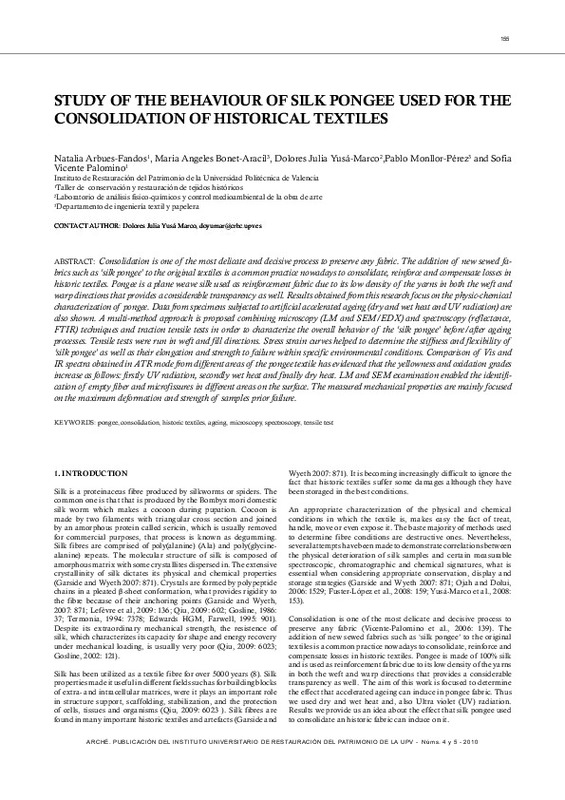JavaScript is disabled for your browser. Some features of this site may not work without it.
Buscar en RiuNet
Listar
Mi cuenta
Estadísticas
Ayuda RiuNet
Admin. UPV
Study of the behaviour of silk pongee used for the consolidation of historical textiles
Mostrar el registro sencillo del ítem
Ficheros en el ítem
| dc.contributor.author | Arbues Fandos, Natalia Concepción
|
es_ES |
| dc.contributor.author | Bonet Aracil, María Angeles
|
es_ES |
| dc.contributor.author | Yusa Marco, Dolores Julia
|
es_ES |
| dc.contributor.author | Monllor Pérez, Pablo
|
es_ES |
| dc.contributor.author | Vicente Palomino, Sofía
|
es_ES |
| dc.date.accessioned | 2013-07-08T06:40:53Z | |
| dc.date.available | 2013-07-08T06:40:53Z | |
| dc.date.issued | 2010 | |
| dc.identifier.issn | 1887-3960 | |
| dc.identifier.uri | http://hdl.handle.net/10251/30713 | |
| dc.description.abstract | Consolidation is one of the most delicate and decisive process to preserve any fabric. The addition of new sewed fabrics such as `silk pongee¿ to the original textiles is a common practice nowadays to consolidate, reinforce and compensate losses in historic textiles. Pongee is a plane weave silk used as reinforcement fabric due to its low density of the yarns in both the weft and warp directions that provides a considerable transparency as well. Results obtained from this research focus on the physic-chemical characterization of pongee. Data from specimens subjected to artificial accelerated ageing (dry and wet heat and UV radiation) are also shown. A multi-method approach is proposed combining microscopy (LM and SEM/EDX) and spectroscopy (reflectance, FTIR) techniques and traction tensile tests in order to characterize the overall behavior of the `silk pongee¿ before/after ageing processes. Tensile tests were run in weft and fill directions. Stress strain curves helped to determine the stiffness and flexibility of `silk pongee¿ as well as their elongation and strength to failure within specific environmental conditions. Comparison of Vis and IR spectra obtained in ATR mode from different areas of the pongee textile has evidenced that the yellowness and oxidation grades increase as follows: firstly UV radiation, secondly wet heat and finally dry heat. LM and SEM examination enabled the identification of empty fiber and microfissures in different areas on the surface. The measured mechanical properties are mainly focused on the maximum deformation and strength of samples prior failure. | es_ES |
| dc.description.abstract | La Consolidación es uno de los procesos de conservación textil más delicados y decisivos a la hora de preservar cualquier tejido. La adicion de un tejido mediante costura como el pongis a un tejido original es una práctica común hoy en día con el fin de consolidar, reforzar y compensar pérdidas en tejidos históricos. El denominado pongis es un tejido de seda de ligamento tafetán, utilizado como tejido de soporte debido a su baja densidad, tanto en trama como en urdimbre, que proporciona una considerable transparencia. Los resultados obtenidos de esta investigación se centran en la caracterización fisicoquímica de este, con el propósito de caracterizar el comportamiento del pongis, antes y después de los procesos de envejecimiento. Se propone la optimización de un método múltiple que combine diferentes técnicas analíticas: microscopia (LM y SEM/EDX), tecnicas de espectroscopia (FTIR-ATR) así como ensayos de tracción que se llevaron a cabo en dirección trama. Las curvas de esfuerzo-deformación obtenidas ayudaron a determinar tanto la rigidez como la flexibilidad del ponguis así como su capacidad de elongación y resistencia previa a la rotura en unas condiciones ambientales específicas. La comparación entre los espectros Vis e IR llevados a cabo en diferentes áreas del tejido evidenciaron que el grado de amarilleamiento y oxidación se acrecienta en el siguiente orden, dependiendo del proceso de envejecimiento: en primer lugar radiación UV, seguidamente calor húmedo y finalmente calor seco. Los exámenes llevados a cabo mediante LM y SEM permitieron la identificación de la totalidad de la fibra y de micro fisuras en diferentes áreas de la superficie. La determinación de las propiedades mecánicas se centra principalmente en la deformación y resistencia máximas de las muestras previa a la rotura. | es_ES |
| dc.format.extent | 4 | es_ES |
| dc.language | Inglés | es_ES |
| dc.publisher | Instituto Universitario de Restauración del Patrimonio de la UPV | es_ES |
| dc.relation.ispartof | Arché | es_ES |
| dc.rights | Reserva de todos los derechos | es_ES |
| dc.subject | Pongee | es_ES |
| dc.subject | Consolidation | es_ES |
| dc.subject | Historic textiles | es_ES |
| dc.subject | Ageing | es_ES |
| dc.subject | Microscopy | es_ES |
| dc.subject | Spectroscopy | es_ES |
| dc.subject | Tensile test | es_ES |
| dc.subject | Consolidación textil | es_ES |
| dc.subject | Tejidos históricos | es_ES |
| dc.subject | Envejecimiento | es_ES |
| dc.subject | Espectroscopia | es_ES |
| dc.subject | Ensayos de tracción | es_ES |
| dc.subject | Electron Microscopy Service of the UPV | es_ES |
| dc.subject.classification | CONSERVACION Y RESTAURACION DE BIENES CULTURALES (UPV) | es_ES |
| dc.title | Study of the behaviour of silk pongee used for the consolidation of historical textiles | es_ES |
| dc.title.alternative | Estudio del comportamiento del pongee de seda como tejido consolidante de tejidos históricos | es_ES |
| dc.type | Artículo | es_ES |
| dc.rights.accessRights | Abierto | es_ES |
| dc.contributor.affiliation | Universitat Politècnica de València. Instituto Universitario de Restauración del Patrimonio - Institut Universitari de Restauració del Patrimoni | es_ES |
| dc.description.bibliographicCitation | Arbues Fandos, NC.; Bonet Aracil, MA.; Yusa Marco, DJ.; Monllor Pérez, P.; Vicente Palomino, S. (2010). Study of the behaviour of silk pongee used for the consolidation of historical textiles. Arché. (4-5):155-158. http://hdl.handle.net/10251/30713 | es_ES |
| dc.description.upvformatpinicio | 155 | es_ES |
| dc.description.upvformatpfin | 158 | es_ES |
| dc.description.issue | 4-5 | es_ES |
| dc.identifier.eissn | 2445-1150 |






